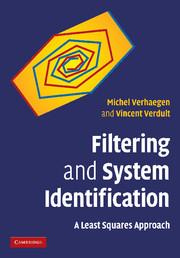Book contents
- Frontmatter
- Contents
- Preface
- Notation and symbols
- List of abbreviations
- 1 Introduction
- 2 Linear algebra
- 3 Discrete-time signals and systems
- 4 Random variables and signals
- 5 Kalman filtering
- 6 Estimation of spectra and frequency-response functions
- 7 Output-error parametric model estimation
- 8 Prediction-error parametric model estimation
- 9 Subspace model identification
- 10 The system-identification cycle
- References
- Index
8 - Prediction-error parametric model estimation
Published online by Cambridge University Press: 14 January 2010
- Frontmatter
- Contents
- Preface
- Notation and symbols
- List of abbreviations
- 1 Introduction
- 2 Linear algebra
- 3 Discrete-time signals and systems
- 4 Random variables and signals
- 5 Kalman filtering
- 6 Estimation of spectra and frequency-response functions
- 7 Output-error parametric model estimation
- 8 Prediction-error parametric model estimation
- 9 Subspace model identification
- 10 The system-identification cycle
- References
- Index
Summary
After studying this chapter you will be able to
describe the prediction-error model-estimation problem;
parameterize the system matrices of a Kalman filter of fixed and known order such that all stable MIMO Kalman filters of that order are presented;
formulate the estimation of the parameters of a given Kalman-filter parameterization via the solution of a nonlinear optimization problem;
evaluate qualitatively the bias in parameter estimation for specific SISO parametric models, such as ARX, ARMAX, output error, and Box–Jenkins models, under the assumption that the signal-generating system does not belong to the class of parameterized Kalman filters; and
describe the problems that may occur in parameter estimation when using data generated in closed-loop operation of the signal-generating system.
Introduction
This chapter continues the discussion started in Chapter 7, on estimating the parameters in an LTI state-space model. It addresses the determination of a model of both the deterministic and the stochastic part of an LTI model.
The objective is to determine, from a finite number of measurements of the input and output sequences, a one-step-ahead predictor given by the stationary Kalman filter without using knowledge of the system and covariance matrices of the stochastic disturbances. In fact, these system and covariance matrices (or alternatively the Kalman gain) need to be estimated from the input and output measurements. Note the difference from the approach followed in Chapter 5, where knowledge of these matrix quantities was used. The restriction imposed on the derivation of a Kalman filter from the data is the assumption of a stationary one-step-ahead predictor of a known order.
- Type
- Chapter
- Information
- Filtering and System IdentificationA Least Squares Approach, pp. 254 - 291Publisher: Cambridge University PressPrint publication year: 2007
- 1
- Cited by



